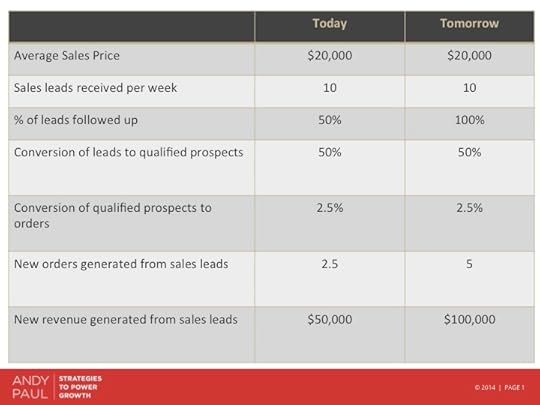Andy Paul's Blog, page 98
May 18, 2015
The Basics Are Still The Best Drivers Of Sales Performance
Sales systems can be like the latest fad diet. And, often, just as ineffective.
And, often, just as ineffective.
Just like dieters who jump from one new exotic diet plan to the next in the hope that the new one will produce better results, so too are sales managers guilty of skipping from one new sales system or methodology to another, hoping to find some magical solution to their team’s sub-par sales performance.
Ultimately, with dieting, the best results are found with the people who consistently focus on the basics: consume fewer calories than the number of calories you burn through exercise.
This value of this common sense prescription is that it is straightforward and simple. It doesn’t rely on rigid eating schedules, complex food preparations, expensive prepared diet meals, or other stratagems. All it requires is a little will power and determination (and simple math skills). Fortunately, if you’re serious about losing and keeping weight off, those factors are under your direct control.
Similarly, many sales systems are rigid, complex, costly to implement and complicated to maintain. Their primary deficiencies are often that they focus on a process to the exclusion of the fundamental, interpersonal, sales skills that are under the individual salesperson’s direct control.
Which is not to say that you shouldn’t employ a sales system. But, no matter which sales system you, or your company, employ, you’ll amp up your personal productivity if you build your individual selling process on a foundation of basic, common sense sales steps that you can execute to help your prospects make fast, favorable decisions.
1. Make every sales touch count
Maximize the impact of every sales interaction with a Value Plan. Before every sales touch with a prospect create a value plan with two elements. The first is a goal that is defined in terms of the value that you will deliver to the prospect during that interaction. And, the second is an outcome defined in terms of the steps the prospect will commit to take as a result of receiving that value. Don’t waste the prospect’s time, or yours, with sales touches that deliver no value.
2. Quickly follow up sales leads
There is no easier way to grow sales than to immediately follow-up all of your true sales leads (meaning someone that reached out and requested to talk to a salesperson). Just like dieting, the math is simple. Let’s assume that your conversion rate of leads into orders is 2%. And let’s also assume that you only follow up 50% of your sales leads (industry research estimates that more than 50% of all sales leads are never followed up). If you keep your conversion rate at 2% but follow-up 100% of your sales leads, what will happen to your sales?
3. Be Absolutely Responsive
Your timeframe for responding to prospects and customers should be immediate. Potential buyers usually will have invested their own time to educate themselves about your product or service before they interact with you for the first time. When they do engage with you, their need for information, by definition, is urgent. Research shows that the first seller with the answers substantially increases their chances of winning the order.
4. Optimize Your Sales Time
As a salesperson, your most valuable asset is your sales time. The easiest way to gain more sales time is to stop wasting it on potential prospects who are not a good fit for your product or services. Most importantly, don’t invest your sales time in poorly qualified prospects just to add another name to your pipeline. Think instead about proactively disqualifying the marginal prospects who distract your focus from the higher value prospects that are more likely to give you an order.
Apply these basic, straightforward, simple and common sense steps to strengthen your sales performance; no matter what sales system you use.
// ]]>
The post The Basics Are Still The Best Drivers Of Sales Performance appeared first on Andy Paul | Strategies to Power Growth.

May 14, 2015
Video Sales Tip: Are You Trying To Win The Sale Or Win The Order?
There’s a critical difference between winning the sale and winning the order. One precedes the other and is a vital step in building the trust, credibility and differentiation that leads to favorable decisions from prospects.
Click below for some tips on how to win the sale. And, the order.
The post Video Sales Tip: Are You Trying To Win The Sale Or Win The Order? appeared first on Andy Paul | Strategies to Power Growth.

May 13, 2015
Is Your Sales Process Aligned With Your Buyers’ Objectives?
Selling is simple if you’re in synch with your buyers.
 At the beginning of my sales career one of my first sales managers assured me, “Andy, selling is simple. It’s not easy. But, it is simple.” Well, sales should be simple. But usually it isn’t.
At the beginning of my sales career one of my first sales managers assured me, “Andy, selling is simple. It’s not easy. But, it is simple.” Well, sales should be simple. But usually it isn’t.
The most effective way to simplify your selling is to make sure that you truly understand your customers’ buying objectives. And, then, make certain that your selling processes are aligned to those objectives.
Buying objectives are not the same as business objectives. Your customers will necessarily have defined business objectives for the products and services that they are evaluating for purchase. These could include achieving a certain internal rate of return on the investment in your product, improving the productivity of their operations, reducing their costs of goods or achieving a certain level of ongoing costs savings.
Customers also have buying objectives for the products they are evaluating for purchase. Acquiring a product or service is a task to be achieved. It’s an item on a to-do list. And, what do people want to do with items on their to-do list? That’s right. They want to check it off as completed and remove it from their list as soon as they can.
To accomplish this, customers need to gather the data and information that they need from potential suppliers (i.e. salespeople) in order to make a good purchase decision. In his best-selling book, Talent is Overrated, the author Geoffrey Colvin noted that “Getting information pushes at the two constraints everyone faces: it takes time and costs money. Making sound decisions fast and at a low cost is a competitive advantage everywhere.” This is your customer’s buying objective: to “make sound decisions fast and at a low cost.”
Your buyers’ largest cost item in gathering the information they need to evaluate the purchase of your product or service is the time of their people. This is time that they could invest in other activities that could contribute to their top or bottom lines. In short, your customers want to gather the information they need to make an informed purchase decision with the least investment of their time possible. This is where you come in. If you want to simplify your selling, and increase your chances of success with your customers, then you need to align your selling process to help them achieve their business objective and their buying objective.
This means that you, as a salesperson, need to strip away every extraneous activity or interaction from your sales process that doesn’t deliver value to your prospects and directly contribute to helping them move at least one step closer to making a decision.
Salespeople have to be prepared to deliver the maximum value each and every time they interact with their customers (irrespective of the method that they are employing – phone, email, social, text, video or in-person calls.)
And, instead of implementing sales processes that are designed for their own convenience, sales managers need to focus on how the customer wants to buy. This means defining and implementing standards for responsiveness and follow-up that have the customer at their core and that maximize the value their sales teams can deliver with their experience, expertise and insights.
Make the extra effort to align how you sell with how your customers make their decisions, and your world will get a little simpler. And a lot more productive.
// ]]>
The post Is Your Sales Process Aligned With Your Buyers’ Objectives? appeared first on Andy Paul | Strategies to Power Growth.

May 12, 2015
The Simplest And Fastest Strategy For Sales Growth
There is no simpler and faster strategy to grow your sales than to quickly and effectively follow-up your sales leads.
 Great sales lead follow-up can be an engine of sales growth for most companies and salespeople. I have helped many to double their sales merely by modifying and accelerating their procedures for following up their sales leads. (Click here to read my post with a definition for a modern sales lead.)
Great sales lead follow-up can be an engine of sales growth for most companies and salespeople. I have helped many to double their sales merely by modifying and accelerating their procedures for following up their sales leads. (Click here to read my post with a definition for a modern sales lead.)
This isn’t a difficult task. The question is: what’s holding you back?
How much money are you leaving on the table?
Various studies have found that among companies of all sizes and industries approximately 50% of sales leads are not followed up. One prominent expert on sales leads, Ken Krogue, President of Insidesales.com, says that studies conducted by his company show that up to 73% of sales leads are never contacted by a salesperson.
Consider for a moment that nearly $250 billion (yes, that is billion with a b) are spent each year on traditional measured media and new media to create buyer interest in products and services. If we use 50% as the benchmark for sales lead follow up, then half of the sales leads generated by those $250 billion are deemed unworthy of follow-up by sales teams. That means that $125 billion in marketing expenditures are essentially flushed down the drain each year due to sales indifference.
Even more important than the wasted money, is the money that’s being left on the table. What is the dollar value of all the orders companies aren’t getting because sales isn’t following up its sales leads?
You have a business decision to make about your time
I’ve never understood a salesperson’s reticence to follow up with a sales lead. After all, as a salesperson you are in many ways your own boss. You get to make the business decision about how to allocate your sales time. You have the freedom to prioritize your activities in order to maximize your sales productivity.
You can choose to generate qualified sales opportunities by talking with potential prospects that have done their research and proactively reached out to you for more information about your product or service. Or, you can make cold calls on suspects who may or may not be aware of your product, who haven’t done their research and who haven’t proactively reached out to you. Which one should you do first?
If you want to make the most productive use of your limited sales time, as measured by the revenue you can generate, you always should choose to follow up on your sales leads first. The probability is higher that you’ll be able to engage in a serious sales conversation with the person who has proactively reached out to you versus the person that receives your cold call and who might never have heard of your company (and hadn’t really been thinking about making a change).
By no means does this mean that you shouldn’t proactively reach out to develop new business. You absolutely should. But not before you have followed up your sales leads.
The simple power of follow up
Here is a simple illustration of the power of responsively following up your sales leads. In the simple sales process I show in the table below, the only change I made from “Today” to “Tomorrow” was to increase the percentage of sales leads that were promptly followed up. All the other conversion rates stayed the same. You can see the results for yourself.

The math is compelling. I’ve seen it work first-hand in many companies that needed a quick, cost-effective strategy to jump start their sales. There are no free lunches in sales. But, this is about as close to one as you will get.
// ]]>
The post The Simplest And Fastest Strategy For Sales Growth appeared first on Andy Paul | Strategies to Power Growth.

May 11, 2015
Avoid 20th Century Thinking About 21st Century Sales Leads
Sales Leads Today Are Not Old-Fashioned Sales Leads
“These are bad leads. I can tell just by looking at them.”
Really? How often have you said that? Or heard other salespeople make this claim? I hate to say it, but I still hear salespeople say this like they believe it.
When so much has changed in how our customers initiate their buying process, how they gather and evaluate the information that they need to make decisions and how they interact with vendors and their salespeople, it’s hard to be believe that salespeople still think that they can accurately guess the potential value of a lead just by glancing at it. When I hear this type of sales talk, I sometimes have to check my calendar to make sure it isn’t still the 1990’s.
What constitutes a sales lead?
A sales lead today is a very different creature than those in the past and it demands a different and proactive response. The Internet provides a low-cost, low-touch means for companies to deliver detailed information about their products and services to any interested party. As a result, the merely curious information seekers no longer have to reach out to a company, and consume its valuable sales time by talking to a salesperson, just to satisfy their basic curiosity about a product or service.
Is someone who fills out a web form to download a white paper, eBook or other content a sales lead? No. They might become one with the right nurturing, but they aren’t one now. On the other hand, someone who fills out a web form, or sends an email, to request that they be contacted by a salesperson is a sales lead. And you’d better be prepared to follow up with them in the least time possible.
A sales lead is no different than you
The easiest way to illustrate the changed nature of sales leads is to think about them in the context of your own buying behavior.
Imagine that you are looking to buy or lease a new car. You go online and look at the websites of various car manufacturers. You’re in an information gathering mode. Seeing what makes and models might fit your needs. You can even price out the options you want and get an idea of the car’s price on the manufacturer’s site. But, if you want to know the specific price you’d have to pay in your hometown or what special financing packages were available, you’d have to fill out a web form to request that information from a dealer in your area. This is an invitation for a salesperson to call you. Which means that you’ll only submit that form if you’re good and ready to talk to a salesperson.
Now, imagine that you’re considering a purchase of a product or service for your business. You’re still in the early stages of your process and not ready to talk to a salesperson. In fact, you’re not really sure whether there are products available that will fit your needs. So, you go online and search. You visit various suppliers’ websites and begin to educate yourself about the products that might meet your requirements. These websites serve up a number of pop-up boxes to get you to enter your contact information, but you don’t do it. At least not yet. Because you’re just not at the stage where you need to talk to a salesperson.
How are you different than your sales leads? If you won’t enter your information into a company’s web form before you’re ready to talk to one of their sales reps, why would they?
A 2010 study showed that more than 90% of all B2B customers conduct some form of online research on a product or service before they engage with a sales person. This means that most potential customers have initiated their buying process prior to ever talking with a salesperson.As a result, the inbound sales leads that a company receives are from a different audience than even 10, 15 and 20 years ago. These are valid leads from people who have done their homework and are deserving of a response by sales.
Effective sales lead follow-up is a core sales process that every company needs to master. It is the easiest and fastest path to find new sources of revenue in nearly every company. But, before you can define and implement this process you have to make the fundamental commitment as a company, and a sales team, to follow up. Try it.
// ]]>
The post Avoid 20th Century Thinking About 21st Century Sales Leads appeared first on Andy Paul | Strategies to Power Growth.

May 7, 2015
Video Sales Tip: Two Tough Questions To Ask After “We’re Not Interested”
I am frequently asked by salespeople, “What should I do when people say they’re not interested?” To answer, I channel my first sales boss, Ray. He had the best, and simplest, answer to this question: “Go find someone who is. “
Click below to watch my video. I’ll help you figure out when to persist and when you should heed Ray’s advice.
The post Video Sales Tip: Two Tough Questions To Ask After “We’re Not Interested” appeared first on Andy Paul | Strategies to Power Growth.

May 6, 2015
Is Your Ego In The Way Of Being A Good Sales Leader?
The problem with being the smartest person in the room.
 It’s hard to resist the temptation to show people just how much you know. And how smart you are. Especially when the people who work for you don’t possess your level of knowledge or experience. When they have sales challenges and problems that need to be addressed, it’s easy to display your vast understanding of the topic and just give them the solution.
It’s hard to resist the temptation to show people just how much you know. And how smart you are. Especially when the people who work for you don’t possess your level of knowledge or experience. When they have sales challenges and problems that need to be addressed, it’s easy to display your vast understanding of the topic and just give them the solution.
In fact, you might even believe that you are being extremely efficient by cutting short a discussion and providing quick answers to questions.
But, your primary responsibility as a sales manager is not to answer questions, solve problems or put out fires. Your job is to help the people you manage learn how to succeed at their jobs. You can’t do that if you feel compelled to be the answer man. When asked a question, don’t just jump in and say “Okay, this is what you should do…”
My first boss in sales, Ray, taught me this lesson very early in my career. “Don’t come to me with your problems. Talk to me about how you think you should solve those problems.”
In your coaching sessions, account reviews and sales meetings, you want to coach people to come to you with their solutions to the problems they’re facing. They shouldn’t ask, “I have this problem with the XYZ Corp deal. What do you think I should do?” Instead, your people should say, “I have this problem with XYZ Corp deal. I’ve thought about how to handle it. And, here’s what I think I should do.”
You have to be a bit like a therapist in this regard. Help your people identify the problem they need to solve, talk about potential solutions and outcomes and have the salesperson decide which would be the best course of action for them to take.
Here are four questions that a sales manager should ask to help his or her salespeople develop solutions to the sales challenges they encounter:
1. What’s the problem that you’re trying to solve?
This is an important starting point. It forces the sales rep to examine their assumptions about the situation that they face with the customer. Accurately defining the problem is where your input can be most valuable.
2. What action(s) do you think you should take?
Be prepared to ask additional questions that will help your salesperson work through the logic of their solution and explore whether there are gaps that need to be filled. Your role is not to judge whether their answer is correct.
3. What will happen if you do that?
It’s not enough for salespeople to know the action they should take. They need to think the problem through to its logical end. What will be the outcome(s) of the strategy that they propose?
4. What’s an alternative solution to that problem?
There’s always more than one way to solve a problem. Challenge the logic of the preferred solution by exploring other options.
After you’ve discussed these questions with your salesperson comes the hard part for you as a manager. Staying quiet. You may not agree with the solution the salesperson has come up with. But, you have to let the salesperson run with their solution, even if you think that they are wrong.
Learn to let go
I worked with one very successful CEO, Ken, who was very good at enabling his people to learn from their mistakes. I remember one meeting with his sales manager who was briefing Ken on the strategy he wanted to take on a particular deal. Ken and I believed that the sales manager and his team were heading in the wrong direction with that account. And, yet, Ken didn’t try to change the sales manager’s mind or tell him what to do.
I asked Ken how he could just let the sales manager go if he thought he was going to fail. He said, “First, it’s just one sale in this person’s career. He’ll recover if he loses. Either way, he’ll take something valuable away from this experience. If I told him what to do, he wouldn’t learn what signs to watch for and how to listen to and read the customer. Second, it’s his strategy. He’ll be much more committed, and accountable, to its outcome than if I forced him to do what I thought was best. And, third, who’s to say that my solution would be more successful? After all, maybe he knows something I don’t.”
If you’re a sales manager, your job is not to be a know-it-all. It’s to be a sales leader. A good sales leader inspires others to act. But, a strong sales leader inspires and prepares others to succeed.
// ]]>
The post Is Your Ego In The Way Of Being A Good Sales Leader? appeared first on Andy Paul | Strategies to Power Growth.

May 5, 2015
How To Avoid A Vicious Sales Cycle
Are you stuck in a vicious sales cycle? Most everyone is familiar with the concept of a vicious cycle, or vicious circle. It is a repeating sequence of connected events in which each cycle negatively reinforces the previous one.
Most everyone is familiar with the concept of a vicious cycle, or vicious circle. It is a repeating sequence of connected events in which each cycle negatively reinforces the previous one.
Unfortunately, I too often see salespeople who are stuck in variation of a vicious cycle, that I call a Vicious Sales Cycle.
A Vicious Sales Cycle flows from bad sales habits that lead to consistently negative results. Combined with an inability, or unwillingness, to change, salespeople can get stuck in a closed loop, self-reinforcing cycle of unacceptable sales performance.
It’s like being trapped in revolving door from which there is no exit. Until you are forced to find a new job.
What are some key behaviors that trap sellers in a vicious sales cycle?
1. Poor call planning and preparation.
Lackadaisical planning and preparation lead to unproductive sales touches. By definition, every sales interaction should deliver value to the prospect that enables them to move closer to making a decision. Absent that, you’re just wasting their time. And yours.
2. Lack of a sense of urgency.
Salespeople who don’t prioritize responsiveness to customers often find themselves on a slippery slope. Prospects are more educated than ever about the products and services they want to buy and when they interact with a salesperson their need for information to continue their buying process is urgent. Any response to a customer request that you defer until later automatically becomes less likely to ever occur.
3. Insufficient product knowledge, industry experience and business acumen.
Complacent sales reps who don’t continually push themselves to learn more about their products, how to sell them and how their customers use them will lag behind their peers in performance. Prospects rely on salespeople to provide the necessary information to help them make a fully informed purchase decision and they’re reluctant to invest their time to build relationships with sellers who can’t provide value.
Three steps to create your Virtuous Sales Cycle
There’s an alternative to a Vicious Sales Cycle. I call it the Virtuous Sales Cycle.
A virtuous cycle is defined as a “Self-propagating advantageous situation in which a successful solution leads to more of a desired result or another success which generates still more desired results or successes in a chain.”
A Virtuous Sales Cycle is what occurs when best sales practices are consistently applied to produce above-average results, which in turn creates an repeating series of positive sales outcomes that feed off of each other to produce consistent high-level performance.
What are a few of the sales behaviors you should use to create and perpetuate your Virtuous Sales Cycle?
1. Maximize the value you deliver with every sales touch.
Every sales interaction with a prospect, no matter how large or small, requires planning and preparation in order to deliver the value they require and achieve the outcomes you desire. I call this Selling with Maximum Impact. Maximize the value you deliver to your prospects with the least investment of their time possible and they’ll invest more time to let you sell to them. Do this well and it results in orders.
2. Be absolutely responsive to the customer in Zero-Time.
The timeframe for every sales reaction to a customer, in other words, responsiveness) should be immediate. Sales is a service that is provided to the prospect in support of their buying process. Without the prospect, sales wouldn’t even exist. Therefore, the needs of your prospects must be given time priority over anything else you could be doing.
3. Invest in your own sales education
Nothing stays the same. Products change. Customers’ requirements change. Technology changes how your customers buy and how you sell your product. Successful salespeople learn how to evolve to keep pace with these changes. They invest their own time, and often money, in their continuing education. (Click here to read my article on how salespeople should invest in their ongoing sales education.)
Embrace a Virtuous Sales cycle to consistently deliver value and sell with maximum impact. Empower your customers to make informed purchase decisions with a smaller investment of their time. This will help you win more orders. It will also create more sales time for you to go out and sell and win orders from additional prospects. Success begets success.
// ]]>
The post How To Avoid A Vicious Sales Cycle appeared first on Andy Paul | Strategies to Power Growth.

May 4, 2015
Unclutter Your Sales Pipeline To Sell More
A big sales pipeline is not always a positive.
 One of the biggest drags on your personal sales productivity can be the size of your pipeline. The problem is that you have too many names on that list that aren’t really worthy of your valuable time and attention. You are spending too much of your limited sales time working on sales opportunities that will never cross the finish line.
One of the biggest drags on your personal sales productivity can be the size of your pipeline. The problem is that you have too many names on that list that aren’t really worthy of your valuable time and attention. You are spending too much of your limited sales time working on sales opportunities that will never cross the finish line.
You might be a skilled salesperson. But if you are trying to apply those skills to a poorly qualified prospect, then it isn’t going to work. It’s like what Robert Heinlein, the world-famous science fiction writer once said about trying to teach a pig to sing. It wastes your time and annoys the pig.
You need to be less focused on increasing the number of opportunities in your pipeline and more focused on increasing the number of opportunities in your pipeline that you can win.
This means that you have to ruthlessly weed out the potential prospects in your pipeline that aren’t truly qualified prospects for your product or service. If you are trying to work on too many prospects at one time, then you will be dissipating your attention and energy among too many opportunities. This means that you aren’t marshaling your focus on your highest value prospects.
Here are a few tips for maximizing the value of your pipeline.
Focus on quality vs quantity
Instead of worrying about building the size your pipeline, focus on making sure that every sales opportunity you are working on is worth that investment of your time. Invest more time up front to ensure that the customer is absolutely qualified to buy precisely what you are selling.
Having unqualified prospects in your pipeline is exactly the same as having no prospects in your pipeline. There is no chance you are going to win an order from either one of them. So why invest even one second of your time on them?
Weed your pipeline regularly
Frequently review every name in your existing pipeline and disqualify those that aren’t realistic opportunities to win. In my first book, Zero-Time Selling, I talked about the need for sellers to disqualify the losers, which means to ruthlessly weed out the unqualified prospects from your pipeline.
Ask yourself this question about each opportunity on your list: “Why am I going to win this deal?” If you can’t identify two unambiguously rock solid differentiators that have quantifiable value to the customer, then the prospect isn’t a winning opportunity and doesn’t belong in your pipeline.
Disqualify quickly
The initial qualification of a sales opportunity should not be an extended process. The goal is to convert shoppers into buyers and quickly shift the customer from a process of discovery to one of intent.
If you are like most salespeople, you are spending a disproportionate amount of your time with customers in the early stages of their buying cycles. In large measure, this is due to indecisive and ineffective qualification. It’s hard to relinquish a potential prospect who has demonstrated some measure of interest in your product or service.
You need to change that ratio. Become focused on quickly disqualifying those potential prospects that aren’t a great fit for your product or service. This will allow you to spend more time in the true value-delivering stages of your sales process with good prospects.
In sum, building a strong pipeline is about addition by subtraction. It’s the antithesis of pipeline mania. You will add to your available selling time, and your ultimate sales success, by subtracting the weak winning opportunities before you waste your time on them.
The post Unclutter Your Sales Pipeline To Sell More appeared first on Andy Paul | Strategies to Power Growth.

May 1, 2015
Video Sales Tip: Are You Selling Or Is Your Customer Buying?
Are you selling or is your customer buying?
This is not a trick question. Click on the video below to understand why it is important for sellers to understand the balance between selling and buying in every sales transaction. You’ll be better prepared to help your prospects achieve their primary objective of making an informed decision to purchase the right product or service to meet their needs.
The post Video Sales Tip: Are You Selling Or Is Your Customer Buying? appeared first on Andy Paul | Strategies to Power Growth.

Andy Paul's Blog
- Andy Paul's profile
- 4 followers




